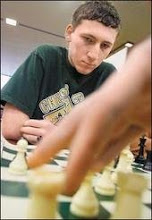Walker - Madison
CCCP July Open, Round 4
1. e4 e5 2. Nf3 Nc6 3. Bb5 a6 4. Bxc6 dxc6 5. Nc3 Bg4?!
This is playable, but it gives up the bishop pair right away, which is black's only advantage.
(5... f6)
6. h3 Bh5?
I show that I am still a bit unfamiliar with Ruy ideas.
7. g4! +/- Bg6 8. Nxe5 Bc5
The idea is Bxf2+ Kxf2 Qd4+ to regain the piece on e5.
9. Nxg6 hxg6 10. Qe2 Nf6 11. d3
(11. e5!? Nd5 12. Ne4 Bb6 13. c4 Ne7 +/-)
11. ...Qd7 12. Be3?
(12. g5? Ng4!! 13. Nd1 (13. f3 Nf2!) 13... Ne5 Is unclear, but black has play for the pawn.)
12... Bxe3 13. Qxe3 Nxg4!

Got my pawn back.
14. Qf3
Forces the retreat of the knight.
14. ...Nf6
(14... O-O-O?? 15. hxg4 +-)
15. O-O-O O-O-O 16. e5 Nd5 17. Ne4!? Qf5
Black sees that the weakness of the white kingside pawns will give good chances without the queens on.
18. Qxf5+ gxf5 19. Ng5 Rdf8
(19... f6?? 20. Nf7)
20. Rde1 Nf4

Now the ...f6 idea is playable, which would win the h-pawn.
21. e6?! = fxe6 22. Nxe6 Nxe6 23. Rxe6 Re8 24. Rxe8+ Rxe8 25. Kd2

Draw offered. I would have accepted, but those kingside pawns look so weak. See if you can figure out a plan to try for a win and then look at what I did.
25 ...Kd7 26. Rg1 Re7 27. Rg5 Ke6 28. Rg3
(28. Ke3?? Kf6+ 29. Kf4 Re2 -+)
28... Kf6 29. h4?!
To stop ...g5, but I think that Re3! is the correct move.
(29. Re3 Rxe3 (29...Rf7 +=) 30. Kxe3 Kg5 31. Kf3 Kh4 32. Kg2 Looks threatening, but white can
make a passer on the queenside which the black king can not reach.)
29... g6 30. Re3?
Now this is a mistake because it wastes a key tempo.
(30. f4! And this should end up drawn.)
30... Rh7! 31. Rh3

Forced.
31. ...f4!! -+
Cuts off the white king, prevents the white rook from going back to e3, and
allows the black king to advance to f5, which will be important in a few moves.
32. Ke2
The only other try is to play on the queenside, but black's pieces
are much more active, so black should still if nothing else have the better
end of a draw.
32. ...Kf5 33. Kf3 g5!
The reason ...f4!! and ...Kf5 needed to be played first. Now white cannot take with check.
34. Rh1 Rxh4 35. Re1
(35. Rxh4 gxh4 36. Kg2 Kg4 37. f3+ Kg5 Now when things start to look dangerous the
black king will run back and devour the white pawns and win.)
35... Rh2!
Much stronger than the obvious ...g4+
36. Re8 g4+ 37. Ke2 g3
Forces the win of the f2 pawn and game.
38. Rf8+

38. ...Ke5 39. d4+ Ke4 40. Re8+ Kxd4 41. Rd8+ Kc5 42. Rg8 Rxf2+ 43. Kd3 g2 44. Rg5+ Kb6 45. Rg4 f3
(45... Rf3+ Is technically more accurate. 46. Ke4 Rg3 47. Rxg3 fxg3)
46. Rg3
(46. Ke3 Rf1)
46... Rf1

And white resigned. 0-1





No comments:
Post a Comment